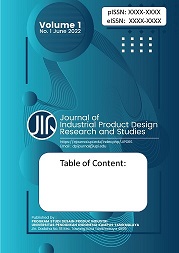Color Identity of Jaya Fried Chicken (JFC) Franchise Brand
Abstract
The purpose of this study is to analyze the implementation of design concepts into color identity, analyze color identity visualization into visual communication media, and formulate suggestions for harmonious color combinations. This study used descriptive qualitative method. Color identity is described in full according to the scope of the study. The description results were analyzed using qualitative methods with Roland Barthes' semiotic theory and Surianto Rustan's color theory. The function of semiotic theory is to analyze the relationship between color identity, design concepts, and business principles. Color theory is used to analyze the visualization of color identity into visual communication media and formulate harmonious color combinations. Data were collected by using observation, documentation, and library techniques. Observations and documentation were carried out by visiting the outlets on Jl. Raya Sakah, Batuan, Sukawati. Documentation includes photos of name signs and packaging. The literature is obtained through books, website, articles, and journals. The results of the study reveal that the color identity of the JFC franchise is in accordance with the Nawa Sanggha concept, namely black, gray, white, and red. Color combinations are able to interpret business principles. Visualization of color identity uses different color portions in its visual communication media. The color portion applies a combination of red, black, and white. Gray color is decorative. The combination of harmonious color portions can follow the value contrast scheme. The combination of red and gray as a sub-ordinate while black and white as an accent or dominant.
Keywords
Full Text:
PDFReferences
Asthararianty, Widodo, P., and Ekobudiwaspada, A. (2016). Mengungkap Nilai-Nilai Simbolis di Balik Warna Tradisional Bali Nawa Sanggha melalui Rancangan Desain Buku. Jurnal Desain Komunikasi Visual Nirmana, 16(1), 18-39
Faizal, M., Abdillah, M. F., IMS, D. A. S., Setiadi, W., Octavia, D., Suhendari, W., and Soewardikoen, D. W. (2018). Penggunaan Website Portal Berita sebagai Media Informasi untuk Mahasiswa. Jurnal Bahasa Rupa, 2(1), 34-42.
Firmansyah, M. Anang. (2019). Pemasaran Produk dan Merek (Planning & Strategy). CV Penerbit Qiara Media, Surabaya.
Hargiyanto, Pipo. (2021), Bisnis Waralaba Indomaret; 7 Langkah Cerdas Menjadi Investor Minimarket. PT Gramedia Pustaka Utama, Jakarta.
Rustan, Surianto. (2017), Layout; Dasar & Penerapannya, PT Gramedia Pustaka Utama, Jakarta.
Rustan, Surianto (2019a), Buku Warna, PT Lintas Kreasi Imaji, Jakarta.
Rustan, Surianto. (2019b), Buku Warni, PT Lintas Kreasi Imaji, Jakarta.
Sobur, Alex. (2003), Semiotika Komunikasi, PT Remaja Rosdakarya, Bandung.
Strauss, Anselm & Juliet Corbin. (2003), Dasar-Dasar Penelitian Kualitatif: Tatalangkah dan Teknik-Teknik Teoritisasi Data, terjemahan Muhammad Shodiq & Imam Muttaqien, Pustaka Pelajar, Yogyakarta.
DOI: https://doi.org/10.17509/jipdrs.v2i1.56196
Refbacks
- There are currently no refbacks.
Copyright (c) 2023 Universitas Pendidikan Indonesia (UPI)

This work is licensed under a Creative Commons Attribution-ShareAlike 4.0 International License.

This work is licensed under a Creative Commons Attribution-ShareAlike 4.0 International License.


